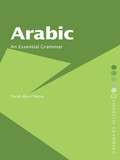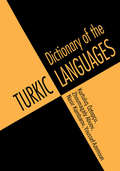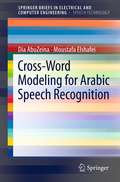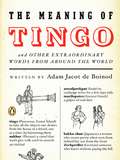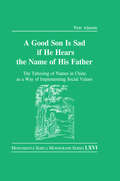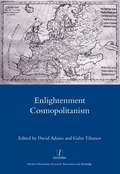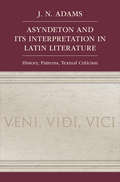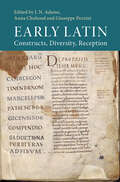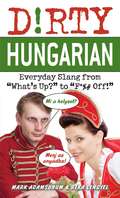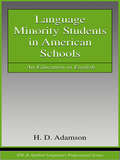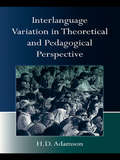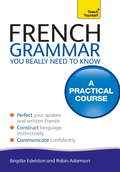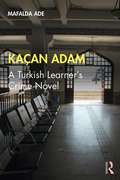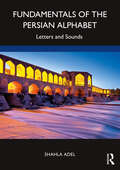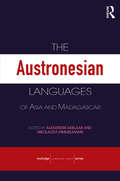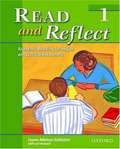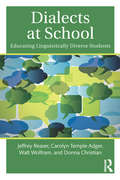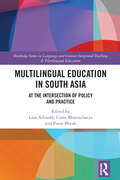- Table View
- List View
Arabic: An Essential Grammar
by Faruk Abu-ChacraArabic: An Essential Grammar is an up-to-date and practical reference guide to the most important aspects of the language. Suitable for beginners, as well as intermediate students, this book offers a strong foundation for learning the fundamental grammar and structure of Arabic. The complexities of the language are set out in short, readable sections, and exercises and examples are provided throughout. The book is ideal for independent learners as well as for classroom study. Features of this book include: coverage of the Arabic script and alphabet a chapter on Arabic handwriting a guide to pronunciation full examples throughout.
Dictionary of Turkic Languages
by Zhoumagaly Abuov Nasir Kambarov Youssef AzemounThis multi-language dictionary covers the eight major Turkic languages: Turkish, Azerbaijani, Turkmen, Uzbek, Uighur, Kazakh, Kirgiz, and Tatar. 2000 headwords in English are translated into each of the eight Turkic languages. Words are organized both alphabetically and topically. Original script and Latin transliteration are provided for each language. For ease of use, alphabetical indices are also given for the eight languages. This is an invaluable reference book for both students and learners and for those enaged in international commerce, research, diplomacy and academic and cultural exchange.
Cross-Word Modeling for Arabic Speech Recognition (SpringerBriefs in Speech Technology)
by Dia Abuzeina Moustafa ElshafeiCross-Word Modeling for Arabic Speech Recognition utilizes phonological rules in order to model the cross-word problem, a merging of adjacent words in speech caused by continuous speech, to enhance the performance of continuous speech recognition systems. The author aims to provide an understanding of the cross-word problem and how it can be avoided, specifically focusing on Arabic phonology using an HHM-based classifier.
I Love Saturdays y Domingos
by Alma Flor AdaA girl discuses the differences between her father's American parents and her mother's Mexican parents. Discuses de una muchacha las diferencias entre los padres americanos de su padre y los padres mexicanos de su madre.
The Meaning of Tingo
by Adam Jacot de BoinodDid you know that people in Indonesia have a word that means 'to take off your clothes in order to dance'? Or how many words the Albanians have for eyebrows and moustaches? Or that the Dutch word for skimming stones is plimpplamppletteren? Drawing on the collective wisdom of over 154 languages, this intriguing book is arranged by theme so you can compare attitudes all over the world to such subjects as food, the human body and the battle of the sexes. Here you can find not only those words for which there is no direct counterpart in English (such as the Japanese age-otori which means looking less attractive after a haircut), but also a frank discussion of exactly how many 'Eskimo' terms there are for snow, and a vast array of information exploring the wonderful and often downright strange world of words. Oh, and tingo means 'to take all the objects one desires from the house of a friend, one at a time, by asking to borrow them'.
Good Son is Sad If He Hears the Name of His Father: The Tabooing of Names in China as a Way of Implementing Social Values (Monumenta Serica Monograph Ser.)
by Piotr AdamekWhen in 1775 the scholar Wang Xihou compiled a dictionary called Ziguan , he wrote, for illustrative purposes, the personal names of Confucius and the three emperors Kangxi, Yongzheng and Qianlong in the introduction. In oversight, he recorded their complete names. This accidental writing of a few names was condemned by Emperor Qianlong as an unprecedented crime, rebellion and high treason. Wang Xihou was executed, his property confiscated and his books were burnt. His family was arrested and his sons and grandsons were killed or sent as slaves to Heilongjiang. It is surprising what an enormous impact the tabooing of names (bihui ) had on Chinese culture. The names of sovereigns, ancestors, officials, teachers, and even friends were all considered taboo, in other words it was prohibited to pronounce them or to record them in writing. In numerous cases characters identical or similar in writing or pronunciation were often avoided as well. The tabooing of names was observed in the family and on the street, in the office and in the emperor's palace. The practice of bihui had serious consequences for the daily lives of the Chinese and for Chinese historiography. People even avoided certain places and things, and refused to accept offices. They were punished and sometimes even killed in connection with the tabooing of names. The bihui custom existed as an important element of Chinese culture and was perceived as significant by Chinese and foreigners alike. It was crucial for implementing social values and demonstrating the political hierarchy. The present work A Good Son Is Sad if He Hears the Name of His Father is a systematic study of Chinese name-tabooing customs, which until now have been relatively little explored in Western-language Sinological studies. It attempts to provide a long-term perspective on the changing dynamics of tabooing and elucidates various aspects related to the fascinating topic of tabooing of names.
Enlightenment Cosmopolitanism
by David AdamsEnlightenment Cosmopolitanism brings together ten innovative contributions by outstanding scholars working across a wide array of disciplines in the humanities and social sciences. Interdisciplinary in its methodology and compass, with a strong comparative European dimension, the volume examines discourses ranging from literature, historiography, music and opera to anthropology and political philosophy. It makes an original contribution to the study of 18th-century ideas of universal peace, progress and wealth as the foundation of future debates on cosmopolitanism. At the same time, it analyses examples of counter-reaction to these ideas and discusses the relevance of the Enlightenment for subsequent polemics on cosmopolitanism, including 21st-century debates in sociology, politics and legal theory.
Asyndeton and its Interpretation in Latin Literature: History, Patterns, Textual Criticism
by J. N. AdamsAsyndetic coordination (omission of coordinators such as 'but', 'or', 'and') is ancient in Indo-European languages. Most commentaries on Greek and Latin texts index 'asyndeton', but wide-ranging treatments of asyndeton across a variety of literary and non-literary genres are largely lacking, and comments are often impressionistic. This book provides the most comprehensive account of asyndeton in Latin ever attempted, and it also contains material from Greek and Umbrian. It analyses asyndeta in diverse genres from early Latin to the early Empire, including prayers and laws, and aims to identify types, determinants, generic variations and chronological changes. Since coordinators are easily left out or added by scribes, criteria are discussed that might be used by editors in deciding between asyndeton and coordination. External influences on Latin, such as Greek and Italic, are also considered. The book will be essential for all scholars of Latin language and literature as well as historical linguistics.
Social Variation and the Latin Language
by J. N. AdamsLanguages show variations according to the social class of speakers and Latin was no exception, as readers of Petronius are aware. The Romance languages have traditionally been regarded as developing out of a 'language of the common people' (Vulgar Latin), but studies of modern languages demonstrate that linguistic change does not merely come, in the social sense, 'from below'. There is change from above, as prestige usages work their way down the social scale, and change may also occur across the social classes. This book is a history of many of the developments undergone by the Latin language as it changed into Romance, demonstrating the varying social levels at which change was initiated. About thirty topics are dealt with, many of them more systematically than ever before. Discussions often start in the early Republic with Plautus, and the book is as much about the literary language as about informal varieties.
Early Latin: Constructs, Diversity, Reception
by J. N. Adams Anna Chahoud Giuseppe Pezzini Charlie KerriganThis is the most detailed and comprehensive study to date of early Latin language, literary and non-literary, featuring twenty-nine chapters by an international team of scholars. 'Early Latin' is interpreted liberally as extending from the period of early inscriptions through to the first quarter of the first century BC. Classical Latin features significantly in the volume, although in a restricted sense. In the classical period there were writers who imitated the Latin of an earlier age, and there were also interpreters of early Latin. Later authors and views on early Latin language are also examined as some of these are relevant to the establishment of the text of earlier writers. A major aim of the book is to define linguistic features of different literary genres, and to address problems such as the limits of periodisation and the definition of the very concept of 'early Latin'.
Early and Late Latin
by James Adams Nigel Vincent Valerie KnightThis book addresses the question of whether there are continuities in Latin spanning the period from the early Republic through to the Romance languages. It is often maintained that various usages admitted by early comedy were rejected later by the literary language but continued in speech, to resurface centuries later in the written record (and in Romance). Are certain similarities between early and late Latin all that they seem, or might they be superficial, reflecting different phenomena at different periods? Most of the chapters, on numerous syntactic and other topics and using different methodologies, have a long chronological range. All attempt to identify patterns of change that might undermine any theory of submerged continuity. The patterns found are summarised in a concluding chapter. The volume addresses classicists with an interest in any of the different periods of Latin, and Romance linguists.
An Anthology of Informal Latin, 200 BC – AD 900
by Adams J. n.This book contains over fifty passages of Latin from 200 BC to AD 900, each with translation and linguistic commentary. It is not intended as an elementary reader (though suitable for university courses), but as an illustrative history of Latin covering more than a millennium, with almost every century represented. Conventional histories cite constructions out of context, whereas this work gives a sense of the period, genre, stylistic aims and idiosyncrasies of specific passages. 'Informal' texts, particularly if they portray talk, reflect linguistic variety and change better than texts adhering to classicising norms. Some of the texts are recent discoveries or little known. Writing tablets are well represented, as are literary and technical texts down to the early medieval period, when striking changes appear. The commentaries identify innovations, discontinuities and phenomena of long duration. Readers will learn much about the diversity and development of Latin.
Dirty Hungarian: Everyday Slang from "What's Up?" to "F*%# Off!" (Dirty Everyday Slang Ser.)
by Mark Adamsbaum Réka LengyelGET D!RTY!Next time you're in Hungary or just chattin' in Hungarian with your friends, drop the textbook formality and bust out with expressions they never teach you in school, including:* cool slang* funny insults* explicit sex terms* raw swear wordsDirty Hungarian teaches the casual expressions heard every day on the streets of Hungary:What's up? Mi a helyzet? Your boyfriend is hot shit. Állat jó pasi a barátod. Dude, I'm so wasted. Öcsém, ugy betintáztam.I gotta take a dump. Mennem kell szarni. Go fuck yourself! Menj a halál faszára! Can I get a blowey? Lecidázol? I'd love to hit that. Szeretném megdöngölni.
Language Minority Students in American Schools: An Education in English (ESL & Applied Linguistics Professional Series)
by H. D. AdamsonThis book addresses questions of language education in the United States, focusing on how to teach the 3.5 million students in American public schools who do not speak English as a native language. These students are at the center of a national debate about the right relationship among ESL, bilingual, and mainstream classes. Bilingual education has been banned by constitutional amendment in California and Arizona, and similar amendments are being considered in other states. Language Minority Students in American Schools: An Education in English places this debate and related issues of teaching standard English to speakers of nonstandard dialects, such as black English, within the larger context of language acquisition theory and current methods of language teaching. Adamson draws from the large body of sociolinguistic, psycholinguistic, and educational research, and on his own experience as an English teacher in the U.S. and overseas, to shed light on some of these controversies and on the cognitive, cultural, public policy, and practical issues involved in educating English language learners. Presenting all sides of the issues fairly, he offers a strong endorsement for bilingual and bidialectical education based on programs designed and administered according to the principles discussed in the book and supported by language acquisition theory and classroom research. A strength of the book is the inclusion of original research conducted in a middle school enrolling a majority of Latino students. This research contributes to the field of language education by providing a detailed description of how English language learners study content subjects. Examples from the study are used to illustrate a discussion of Vygotskian learning principles and the relationship between the students' home and school cultures. Language Minority Students in American Schools: An Education in English is intended for students who are preparing to become teachers of English as a second language, and for teachers of other subjects who work with English language learners.
Interlanguage Variation in Theoretical and Pedagogical Perspective
by H.D. AdamsonIn this book H.D. Adamson reviews scholarship in sociolinguistics and second language acquisition, comparing theories of variation in first and second-language speech, with special attention to the psychological underpinnings of variation theory. Interlanguage is what second language learners speak. It contains syntactic, morphological and phonological patterns that are not those of either the first or the second language, and which can be analyzed using the principles and techniques of variation theory. Interlanguage Variation in Theoretical and Pedagogical Perspective: relates the emerging field of variation in second language learners’ speech (interlanguage) to the established field of variation in native speakers’ speech relates the theory of linguistic variation with psycholinguistic models of language processing relates sociolinguistic variation theory to the theory of Cognitive Grammar suggests teaching applications that follow from the theoretical discussion At the forefront of scholarship in the fields of interlanguage and variation theory scholarship, this book is directed to graduate students and researchers in applied English linguistics and second language acquisition, especially those with a background in sociolinguistics.
French Grammar You Really Need To Know: Teach Yourself
by Robin AdamsonComprehensive and clear explanations of key grammar patterns and structures are reinforced and contextualized through authentic materials. You will not only learn how to construct grammar correctly, but when and where to use it so you sound natural and appropriate. French Grammar You Really Need to Know will help you gain the intuition you need to become a confident communicator in your new language.
French Grammar You Really Need To Know: Teach Yourself
by Robin AdamsonComprehensive and clear explanations of key grammar patterns and structures are reinforced and contextualized through authentic materials. You will not only learn how to construct grammar correctly, but when and where to use it so you sound natural and appropriate. French Grammar You Really Need to Know will help you gain the intuition you need to become a confident communicator in your new language.
Kaçan Adam: A Turkish Learner’s Crime Novel
by Mafalda AdeAimed at intermediate Turkish learners, Kaçan Adam: A Turkish Learner’s Crime Novel is a short mystery / detective story in idiomatic Turkish complete with exercises, vocabulary and grammar review. Over the course of 24 lively chapters, it follows the fate of former intelligence officer Erkan Demirel, who has been convicted of selling secret military documents but who manages to escape from prison and embarks on a quest to prove his innocence… For use either as a supplement to classroom instruction (CEFR A2-B1 and ACTFL, Lower Intermediate Level) or individually, this book will guide students through their first complete novel in Turkish while revising and reinforcing key points of modern Turkish grammar and expression.
Fundamentals of the Persian Alphabet: Letters and Sounds
by Shahla AdelFundamentals of the Persian Alphabet introduces complete beginners to the letters and sounds of Persian through pronunciation, basic vocabulary and phrases, conversation, and Persian culture. Students are also introduced to the distinction between the formal and informal forms of the language. As knowledge of letter–sound correspondence and phonological awareness is key to language learning, this textbook ensures learners start their learning journey with a strong foundation. This book is divided into six lessons presenting the modern Persian alphabet in groups of mostly similarly shaped letters that will allow learners to begin blending letters and segmenting words as soon as possible to make learning easier. With the guidance of additional audio and video resources, a comprehensive Persian–English glossary, and listening, speaking, reading, and writing exercises throughout the book, students will acquire the fundamental skills and knowledge for furthering their learning of the language. The ideal starting point for beginners, Fundamentals of the Persian Alphabet is designed for learners with very little or no previous knowledge of the language and is suitable for both independent and class-based study.
The Austronesian Languages of Asia and Madagascar (Routledge Language Family Ser. #Vol. 7)
by Alexander Adelaar Nikolaus P. HimmelmannSome 800 Austronesian languages are spoken in the area extending from Madagascar to eastern Indonesia and to the north to Taiwan and the Philippines. They vary greatly in almost every possible respect, including the size and social make-up of the speech communities and their typological profiles. This book is designed to serve as a reference work a
Read and Reflect 1: Academic Reading Strategies and Cultural Awareness
by Jayme Adelson-Goldstein Lori HowardThis book is ideal for young adults planning to pursue a college education; however, it can also be used by students who want to improve their reading skills to attain a personal goal or to advance in the workplace.
Dialects at School: Educating Linguistically Diverse Students
by Carolyn Temple Adger Donna Christian Jeffrey Reaser Walt WolframLike its predecessor, Dialects in Schools and Communities, this book illuminates major language-related issues that educational practitioners confront, such as responding to dialect related features in students’ speech and writing, teaching Standard English, teaching students about dialects, and distinguishing dialect difference from language disorders. It approaches these issues from a practical perspective rooted in sociolinguistic research, with a focus on the research base for accommodating dialect differences in schools. Expanded coverage includes research on teaching and learning and attention to English language learners. All chapters include essential information about language variation, language attitudes, and principles of handling dialect differences in schools; classroom-based samples illustrating the application of these principles; and an annotated resources list for further reading. The text is supported by a Companion Website (www.routledge.com/cw/Reaser) providing additional resources including activities, discussion questions, and audio/visual enhancements that illustrate important information and/or pedagogical approaches. Comprehensive and authoritative, Dialects at School reflects both the relevant research bases in linguistics and education and educational practices concerning language variation. The problems and examples included are authentic, coming from the authors’ own research, observations and interactions in public school classrooms, and feedback in workshops. Highlights include chapters on oral language and reading and writing in dialectally diverse classrooms, as well as a chapter on language awareness for students, offering a clear and compelling overview of how teachers can inspire students to learn more about language variation, including their own community language patterns. An inventory of dialect features in the Appendix organizes and expands on the structural descriptions presented in the chapters.
Multilingual Education in South Asia: At the Intersection of Policy and Practice (Routledge Series in Language and Content Integrated Teaching & Plurilingual Education)
by Lina Adinolfi Usree Bhattacharya Prem PhyakSpanning scholarly contributions from India, Nepal, Bangladesh, Pakistan, and Sri Lanka, this edited volume seeks to capture and elucidate the distinct challenges, approaches and possible solutions associated with interpreting, adapting and applying language-in-education policies in a range of linguistically complex teaching and learning environments across South Asia. Centring on-the-ground perspectives of scholars, practitioners, pupils, parents and the larger community, the volume offers new insights into one of the most complex, populous, and diverse multilingual educational contexts in the world. Language-in-education policies and practices within this setting represent particularly high stakes issues, playing a pivotal role in determining access to literacy, thereby forming a critical pivot in the reproduction of educational inequality. The broad aim of the collection is thus to highlight the pedagogical, practical, ideological and identity-related implications arising from current language-in-education policies in this region, with the aim of illustrating how systemic inequality is intertwined with such policies and their associated interpretations. Aimed at both academics and practitioners - whether researchers and students in the fields of education, linguistics, sociology, anthropology or South Asian studies, on the one hand, or language policy advisors, curriculum developers, teacher educators, teachers, and members of funding bodies, aid providers or NGOs, on the other - it is anticipated that the accounts in this volume will offer their readership opportunities to consider their wider implications and applications across other rich multilingual settings – be these local, regional, national or global.
The Acquisition of Creole Languages
by Dany AdoneHow do children acquire a Creole as their first language? This relatively underexplored question is the starting point for this first book of its kind; it also asks how first language acquisition of a Creole differs from that of a non-Creole language. Dany Adone reveals that in the absence of a conventional language model, Creole children acquire language and go beyond the input they receive. This study discusses the role of input, a hotly debated issue in the field of first language acquisition, and provides support for the nativist approach in the debate between nativism and input-based models. The Acquisition of Creole Languages will be essential reading for those in the fields of first language acquisition and Creole studies. Adone takes an interdisciplinary approach, using insights from non-verbal language acquisition, which makes this of great interest to those in the field of sign linguistics.
Cambridge IGCSE™ German Student Book Second Edition
by Mariela Affum Amy Bates Alice Gruber Helen Kent Janet Searle Zoe ThorneThis title is endorsed by Cambridge Assessment International Education to support the full syllabus for examination from 2021.Strengthen language skills and cultural awareness with a differentiated approach that offers comprehensive coverage of the revised Cambridge IGCSE™ German (0525/7159) syllabuses for first examination from 2021.- Develop the cultural awareness at the heart of the syllabus with engaging stimulus material and questions from around the world which will encourage a positive attitude towards other cultures- Progress the ability to use the language effectively with activities developing all four key skills, supported by teacher notes and answers in the teacher guide- Stretch and challenge students to achieve their best, whilst supporting all abilities with differentiated content throughout- Ensure the progression required for further study at A-level or equivalent- Help to prepare for the examination with exam-style questions throughoutAudio is available via the Boost eBook, Boost subscription or the Teacher Guide.Also available in the seriesReading and Listening Skills Workbook ISBN: 9781398329423Grammar Workbook ISBN: 9781510448056 Vocabulary Workbook ISBN: 9781510448063 Study and Revision Guide ISBN: 9781510448186 Boost eBook: 9781398329591Boost digital teacher resources ISBN: 9781398329546Teacher Guide with audio ISBN: 9781510448544
